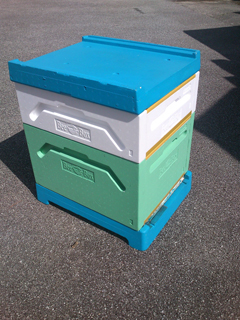 I feel so frustrated! It is now almost May and I haven’t had the opportunity (or weather!) to open up my hives and check what is going on inside. Judging by the numbers of bees flying from many of them, the queens have been laying full tilt, so it is likely that, the minute we get a spell (rather than an hour or two) of good weather, the bees will be in swarming mode because they are getting congested. I am talking generally – at least I hope so!
I feel so frustrated! It is now almost May and I haven’t had the opportunity (or weather!) to open up my hives and check what is going on inside. Judging by the numbers of bees flying from many of them, the queens have been laying full tilt, so it is likely that, the minute we get a spell (rather than an hour or two) of good weather, the bees will be in swarming mode because they are getting congested. I am talking generally – at least I hope so!
I have tried to anticipate this urge in my bees by increasing the queen’s laying space by adding extra brood boxes to many of the stronger colonies. This might help the situation but without knowing how much free laying space is in those boxes I am only guessing what is going on.
There is a lot of nectar being brought in by the bees at the moment and this is likely to be stored, at least initially, in the brood box(es), thereby reducing what is available for the queen to lay in. I have also added supers (the honey storage boxes) above those colonies that appeared to need them, thus giving the bees the choice of storing nectar “upstairs” and away from the brood-nest area, but that’s up to them. Hopefully, the weather will make the jump into Spring very shortly and I can then check what’s going on.
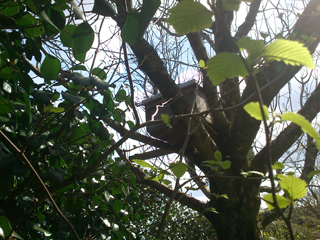 In the meantime, I have placed “bait hives” around my home apiary to offer accommodation for any swarms that come out prior to my being able to check colony status. The hives in my out-apiaries have all been given plenty of super space, as there appears to be quite a lot of rape fields around again this year and if the weather is warm enough for the rape to produce (as it has been for a few hours here and there) the bees will avidly bring in the nectar from these fields, crowd the brood box if there are no supers on (thereby reducing drastically the queen’s laying space) – and swarm! I have tried to anticipate this but you never can tell.
In the meantime, I have placed “bait hives” around my home apiary to offer accommodation for any swarms that come out prior to my being able to check colony status. The hives in my out-apiaries have all been given plenty of super space, as there appears to be quite a lot of rape fields around again this year and if the weather is warm enough for the rape to produce (as it has been for a few hours here and there) the bees will avidly bring in the nectar from these fields, crowd the brood box if there are no supers on (thereby reducing drastically the queen’s laying space) – and swarm! I have tried to anticipate this but you never can tell.
You may recall that three years ago I was given a top-bar hive. This has been most successful in terms of colony development and what is referred to as “natural beekeeping”. The bees appear to be able to combat Varroa more readily than colonies in traditional hives, partly, I believe, because there is less intervention (by me) disrupting their daily routine and the fact that they are allowed to draw their comb to the cell-size that they choose, rather than what is impose upon them by the beekeeper through using wax foundation sheets.
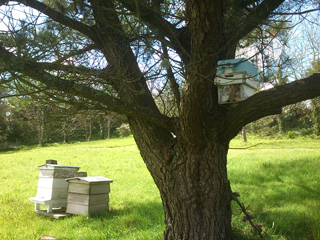 I was hoping to be able to say the same for my Warr hive (which I built two years ago) but unfortunately the colony swarmed (so much for “natural beekeeping”, perhaps!!) and the virgin queen left behind did not mate satisfactorily, so the colony died. I shall try again this year by once more populating this hive with a swarm (hopefully, not one of mine!).
I was hoping to be able to say the same for my Warr hive (which I built two years ago) but unfortunately the colony swarmed (so much for “natural beekeeping”, perhaps!!) and the virgin queen left behind did not mate satisfactorily, so the colony died. I shall try again this year by once more populating this hive with a swarm (hopefully, not one of mine!).
To add to this motley collection of bee-hive types (the books always say “avoid mixing hive types”), I have recently bought a polystyrene (yes, I know!) Langstroth jumbo hive, just as an experiment. I have always been dead against polystyrene as a hive material, but I’ve decided to be a little more open-minded and am giving it a try.
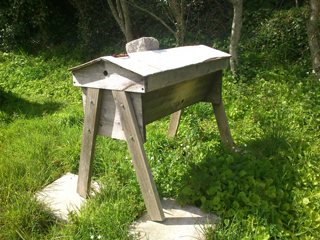 Thinking about it, as I have been, the polystyrene in these hives is a lot denser than the the packaging we get when we buy new white goods, so will hopefully not give off the chemicals that have previously deterred me. Also, bees normally coat the inside of their hive space with propolis (an antiseptic, anti-bacterial tree resin collected by them), thereby sealing in any noxious substances, including bacterial spores.
Thinking about it, as I have been, the polystyrene in these hives is a lot denser than the the packaging we get when we buy new white goods, so will hopefully not give off the chemicals that have previously deterred me. Also, bees normally coat the inside of their hive space with propolis (an antiseptic, anti-bacterial tree resin collected by them), thereby sealing in any noxious substances, including bacterial spores.
In this case, if they do so, it should seal in any fumes that might be given off by the polystyrene. Additionally, if they don’t propolise the walls, then I can put my mind at rest that these fumes are either not there or are not a problem. Many beekeepers extol the virtues of such hives in terms of over-wintering of the bees, so, as a teacher of beekeeping to novices, I have to have an open mind, and facts rather than hear-say, to teach objectively. More on this later in the season, hopefully.
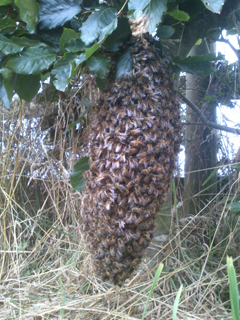 Finally, it’s that time of year again, as I mentioned earlier – the swarming season! I have prepared as best I can to limit the likelihood of my bees swarming but others may have not or may be unlucky (as may I be). In this case, a swarm may issue from a beehive round about midday and start looking for a home.
Finally, it’s that time of year again, as I mentioned earlier – the swarming season! I have prepared as best I can to limit the likelihood of my bees swarming but others may have not or may be unlucky (as may I be). In this case, a swarm may issue from a beehive round about midday and start looking for a home.
Before it enters your chimney or roof-space, if you see a swarm hanging in a tree – or anywhere, for that matter – do please get in touch (by phone, please – emails are unlikely to be looked at during the day, so by the time I read them, any swarm reported will have gone) and I will arrange for its collection, either by myself or by someone who lives nearer to you. There is no charge if it’s a straightforward swarm but once the bees enter a roof-space or somewhere similar, then a cost is likely.
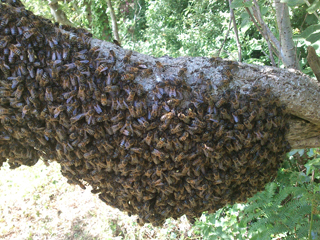 A typical swarm, once settled, will look like a large bunch of grapes hanging from a branch, or perhaps will just be a black mass on a fence post or on a wall – in fact, anywhere is possible. I have collected swarms for a Wendy House, an electricity meter cupboard, a wire fence, a gate-post, inside a ceanothus bush, on a gable-end wall, and more. Wherever they initially pitch, they won’t stay there for long – perhaps an hour or so, or even less – before they are off to their final chosen destination.
A typical swarm, once settled, will look like a large bunch of grapes hanging from a branch, or perhaps will just be a black mass on a fence post or on a wall – in fact, anywhere is possible. I have collected swarms for a Wendy House, an electricity meter cupboard, a wire fence, a gate-post, inside a ceanothus bush, on a gable-end wall, and more. Wherever they initially pitch, they won’t stay there for long – perhaps an hour or so, or even less – before they are off to their final chosen destination.
Speed, therefore, is of the essence and as you are all aware of the importance of honey bees to our lives and our planet, please don’t give them the chance to find what they regard as a suitable home. We can’t afford to have swarms ending up in inaccessible places where they can’t be treated for Varroa because they will then likely die.
Good swarm-spotting – and here’s hoping for some more-seasonally-appropriate weather.
Colin Rees – 01872 501313 – colinbeeman@aol.com

